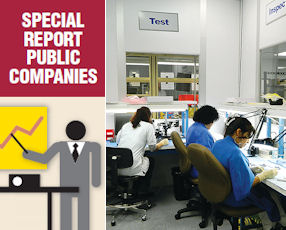Interlink Electronics Inc. is tackling the high cost of research and development of touch-sensor technology and getting new products to market quicker by joining the corporate affiliates program at the University of California, Santa Barbara. The affiliates program was founded to make it easier for industry to have access to faculty, students and alumni working in areas of expertise those companies need – and to work together for research grants. In joining the program, the Camarillo manufacturer finds itself among some elite company, including corporate heavyweights Northrop Grumman Corp. and Microsoft Corp. Thousand Oaks-based Teledyne Technologies Inc. is also a member. The university does not share in the rights to any technology developed by program members using the school’s facilities and equipment. But the members pay a fee on a sliding scale – $10,000 for smaller companies to $25,000 for multinationals. For Interlink the benefits of membership are collaborating with the school’s instructors with knowledge in microelectronics, a key component for the sensor technologies used in consumer electronics, medical, industrial and military applications. The company, for example, makes the touchpads for the Panasonic Corp. Toughbook laptop. Joint R&D with the university will allow Interlink to get new products out quicker which is key to success in the competitive markets it supplies to, particularly consumer electronic, said Howard Goldberg, executive vice president of business development. “Not everything has to be developed in-house,” Goldberg said. In addition to the Camarillo headquarters and plant, Interlink has a facility in China and employs a total of 85 workers. It spent $201,000 on research and development in the third quarter, during which it only recorded $34,000 in net income on $1.6 million in revenue. (The company trades on the Pink Sheets and that is the most recent financial data available.) The company expects to continue its current level of R&D spending in the near term, but the UC Santa Barbara program should help it shoulder the burden of future costs. “The affiliates program will reduce our future R&D spent in terms of Interlink entering into new markets and applications,” Goldberg said. “As a result it will have an indirect impact on future financials by allowing us to get to new markets and applications more quickly and cost effectively.” The university started the program in 2006, modeling it after a similar program at UC San Diego. As state and federal funding for the school has decreased, private enterprise has stepped in to fill the gap. The companies co-author research grant applications with the university. “We emphasize long term relations by co-developing technology,” said Leslie Edwards, director of Corporate Business Development at UC Santa Barbara. Raytheon Vision Systems, located in Goleta about a mile from the UC Santa Barbara campus, has been a part of the corporate affiliate program since the beginning. A unit of Raytheon Co. of Waltham, Mass., it benefits from the program in three ways: access to faculty, students, and equipment and facilities, said Andreas Hampp, manager of advanced development. Raytheon Vision has worked at the university on a number of programs, including exploring the use of different materials to make infrared sensors. The university has the equipment needed to work with microelectronics to test out whether a proposed technology can work. “No company is going to invest $3 million to prove a concept,” Hampp said. “UCSB allows me to prove concepts.” In addition, the program facilitates access to the faculty and departments at a school with more than 1,000 academic staff members. Hampp said Edwards and her staff have backgrounds in industry and so know what the member companies need. “She can facilitate the initial step in the collaboration,” he said. Edwards said she and others in the program visit up to 30 new companies a year to pick new corporate partners. In the case of Interlink, the program made sense because of its work in circuits, electronics and sensors. “We have some hugely funded faculty in electronics and optoelectronics and that is the field that Interlink is interested in,” Edwards said.
